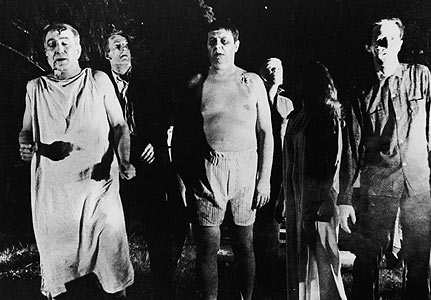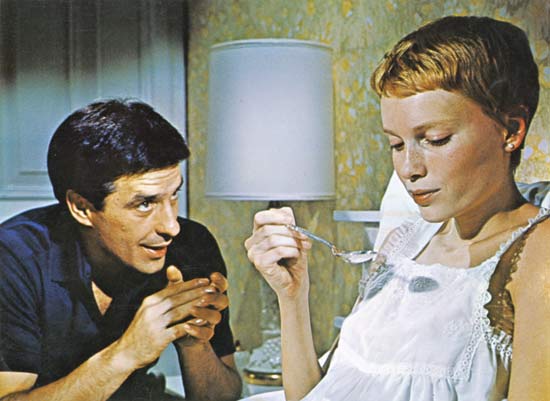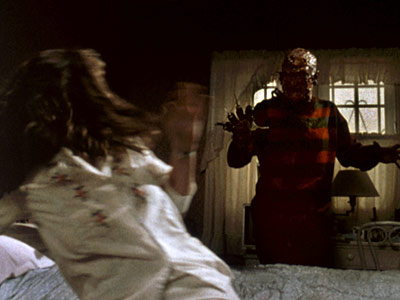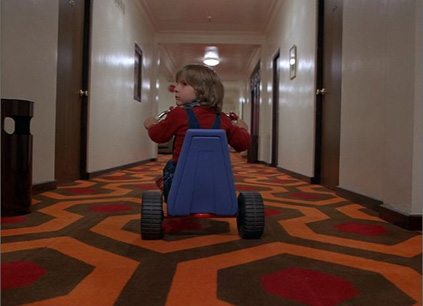Don’t Like Horror Movies? 5 Films to Change Your Mind
So you’re not a scary movie person. When Halloween rolls around and cable stations start playing horror movie marathons, you don’t get a delightful chill or feel the need to hit up (insert choice of movie rental service) for the original “Halloween” or some other ’80s slasher movie or zombie classic.
I’m here to tell you that’s okay; I’ve been there. In fact, if I had never opened myself up to more horror movies since beginning to blog about film, I’d still be there. Ok, so you love movies, but you “don’t do horror”; it doesn’t mean there isn’t a horror movie for you and that you have to let Halloween go by without participation in the horror movie “ritual.” So I’ve gone into my review archives and found five horror films for people who don’t love or are terrified by most horror movies that could change your mind about the genre — and maybe even make you a fan. They did for me.
Psycho (1960)
Let’s start with the obvious. Alfred Hitchcock’s masterpiece is the highest rated horror film on imdb.com for a reason. If you haven’t seen it, then this list is no longer about horror movies that might change your mind, but about making sure you’ve seen a classic movie before you embarrass your inner movie buff.
Like any Hitchcock film (and like most films in this post), “Psycho” is about suspense. Suspense is one if not the most powerful element a film can possess and that’s why it’s usually cited as a major component in all universally praised or classic horror films. If a horror film has bad, cheap, inorganic or no buildup, it’s garbage. “Psycho” plays it cool at first, leaving you on edge until something starts to happen. Then it builds slowly by use of mystery/thriller suspense tactics and then it climaxes in a few carefully chosen points throughout capped with exquisite horror moments that burn images into your memory.
If you’ve gone a couple decades in life without seeing this film and having never had its twist ruined for you, then see it now because someone will. The first twist was ruined for me years ago because it involves the most iconic scene in horror movie history, but I had the great pleasure of not knowing the final one and the buildup was that much more effective as a result.
“Psycho” is about great execution and fantastic pacing, which makes it appreciable for any film-lover. For those scared off by horror movies because they’re gory or use cheap pop-out scare tactics, have no fear because “Psycho” doesn’t. Plus, there’s no supernatural element, so it’s a film you can buy into easily. Basically, get going if you haven’t seen it and make it priority number one.
—
Night of the Living Dead (1968)
I don’t get what the zombie craze is all about either, quite frankly, but I do know that of all them, “Night of the Living Dead” is one of the best. I haven’t seen “Dawn of the Dead” yet, but this was first, so it’s a better recommendation regardless. Anyway, whether the undead intrigue you or not, George A. Romero’s first of what have become several zombie films is more than just a creature feature.
The film is definitely wrought with cliche horror movie violence and cheesy gore (though it was the first to do so, so hard to call it cliche exactly) but the black and white element and the fact that it was made, oh yeah, more than 40 years ago, mean there’s nothing to be grossed out about. If you enjoy the balance between horror/gore and physical comedy, I have a whole other list of films for you, but “Living Dead” walks it in that innocent “this genre will be exploited in the future for comedic purposes” sort of way.
But the real reason “Night of the Living Dead” serves as a great gateway film to horror is the social commentary. Fresh off the heels of the Civil Rights Era we have a black protagonist leading a group of people boarded up in a house together trying to fight off the undead. Top that with all the arguing the people inside do as to how they should handle the situation and you have an intriguing film about what happens when people are locked up together and in survival mode. (It can get nasty.) “Living Dead” deserves to forever be commended for being the first to combine horror/gore with group psychology.
—
Rosemary’s Baby (1968)
Also in 1968 was the film “Rosemary’s Baby” from director/writer Roman Polanski. I mentioned that “Psycho” was a brilliant execution of suspense, but no film probably plays with your mind more than this story of a young wife (Mia Farrow) who becomes pregnant and incredibly paranoid about her baby.
There are no scare tactics or scary images (just a few weird ones) in this film, but Polanski convinces you one is coming at numerous points throughout the film, which will keep you on edge. Many films have confused the audience to the point that they don’t know what to believe, but the concept of pregnancy and the film’s centering on the unique character of Rosemary makes it extremely unique and definitely freakier.
“Rosemary’s Baby” will enhance your appetite for the kind of suspense that only horror films can really deliver, even if the film itself is more thriller. The suspense and paranoia is just exceptional and the creepy tone definitely makes horror the most applicable genre, however.
—
A Nightmare on Elm Street (1984)
Now you’re thinking huh, a slasher movie? Freddy Krueger and the knife fingers? Yes, now let me explain. I watched “A Nightmare on Elm Street” for the first time this year after all the hype/revisiting of the originals when the Jackie Earle Haley-starring remake came out back in April. The concept of a killer who walks both the real world and dreamworld seemed more original and exciting than the “creepy guy kills off hot people one at a time” concept that’s pervaded horror movies in the last 10 – 15 years.
Fewer than a handful of people die in Wes Craven’s classic, which tells you where its priority is: the suspense. There’s an intense build-up before each of the deaths in this film and when they happen they are so effective because a.) the special effects in this movie were pretty good for 1984 and b.) the deaths have a fantastical twist to them because Freddy exists in the dream world. So in essence, very classic suspense techniques lead up to one-of-a-kind scary death moments.
But what makes Freddy easier to transition to as far as slasher goes is that the guy’s a nutjob. He’s not menacing or scary at all. Robert Englund has fun with the part and it takes some of the tension out, making the film much more enjoyable. Unlike what you’d expect, you don’t have trouble going to sleep that night after watching it (although I admit to watching this film in the middle of the afternoon …).
—
The Shining (1980)
It’s been awhile since I’ve seen this film, but I’ve become very well-versed in Stanley Kubrick since. He’s the big draw here and the reason why even if you don’t love horror, you have to see “The Shining.”
If you haven’t figured it out by now, this list of five films has been about suspense, suspense, suspense. The buildup in all these films has made them rank among the best of all time. If killing people and gore were enough, we’d have a very different list. The slow descent into madness is a common theme in films, but no horror film executes it better than “The Shining.” I suppose “Rosemary’s Baby” comes close, but it’s not the same kind of madness so much as paranoia.
Jack Torrence takes his family with him to the Overlook Hotel in isolated Colorado where his young son Danny sees some disturbing images. (I suppose if “Psycho” and the Bates Motel never existed, the freaky hotel motif would’ve eventually been born with this film.) Kubrick treats the “scary” images in this film like art, framing them with a creepy sort of elegance that’s simply unforgettable. In terms of pacing/tension, consider that this was the man who had the patience to create the eternally dragging and strange “2001: A Space Odyssey,” and you can imagine the buildup. The turn of events in this film are also amazingly effective.
There’s so many other film-related things to appreciate in “The Shining” that it is so much more than the scares.










0 Comments
You can be the first one to leave a comment.